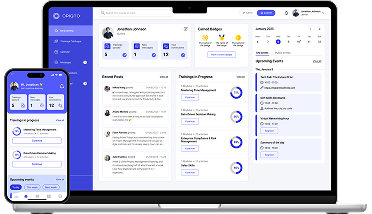Each year, e-learning becomes a bigger part of a learning and development professional’s focus. According to LinkedIn’s 2020 Workplace Learning Report, 38% of L&D professionals are expecting to spend less this year on instructor-led training, while 57% are expecting to spend more on online learning.
E-learning is becoming popular because of its reach, flexibility, and popularity with learners — especially as Millennial and Generation Z workers start to become majorities in the workplace. But e-learning is not without its challenges.
Here are the top 10 learning and development challenges L&D professionals are faced with each day.
1. Keeping training materials current
Regulations, company policies, and procedures are always changing — which means that training materials are constantly going out of date. If your learning content is all physical, it can be difficult to update. With online learning, it’s simple to make a quick change and keep your corporate training program up-to-date.
2. Developing new learning content quickly
Rolling out a new learning experience takes time. But when you have a learning management system with intuitive, simple-to-use authoring tools, it’s simpler to get your own learning content developed quickly.
3. Getting employees to make time for training
Your employees have dozens of things on their plate every day — and most of the time, taking a training course is very low on the list. Fortunately, on-demand learning lets you create interactive microlearning modules that a user can access training from anywhere, making it more likely that they’ll fit learning content into their schedule.
4. Keeping learners engaged
Busy employees don’t want to sit through boring training. And they’re less likely to retain knowledge if they’re not engaged. Take advantage of online learning tools like badges, gamification, social learning, forums, and other tools to improve learner engagement.
5. Personalizing the training
Even worse than training that’s not engaging is having to sit through content that’s not relevant. Everyone has their own learning process A LMS makes it easy to create adaptive learning paths that automatically tailor modules to learners based on skill level, role, and other qualifications that you set.
6. Offering just-in-time learning
Throughout the day, employees are constantly in need of quick trainings. In the past, this continuous learning was often informally obtained — for example, asking a coworker for help or advice. Along with a structured learning path, you can make just-in-time learning constantly available, with snippets of training modules available on their mobile device.
7. Tracking and assessing learning
How can you tell who’s completed what training courses, or how well they did? A good learning management system will have powerful analytic tools to help you see at a glance how your training is performing.
8. Demonstrating the value of training programs to leadership
Historically, another one of the learning and development challenges has been that it's difficult to prove why L&D is so valuable. With a better way to track and assess learning through your LMS, you’ll also be able to better demonstrate the value of your training programs to leadership.
9. Staying within the budget
Training can be expensive: creating training content, materials, instructors, and travel all cost money, not to mention the time off work. A good learning management system allows you to do more with less, delivering training virtually and effectively, with less time required.
10. Finding the right training platform
One of the biggest elearning challenges L&D professionals face is in finding the right LMS to help them see all the other benefits we’ve already talked about.
At Opigno LMS, we make that easy. Discover the world’s #1 open-source Drupal-based learning management system. Book a demo today.
Author: Adam Kennedy-Ripon
Design: Simon Contreras
